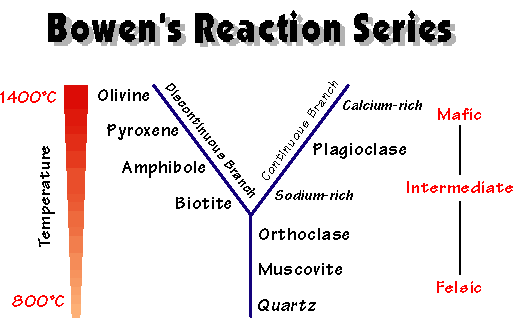Ask GeoMan...
What is Bowen's Reaction Series?
Back in the early 1900's, N. L. Bowen and others at the Geophysical Laboratories in Washington D.C. began experimental studies into the order of crystallization of the common silicate minerals from a magma. The idealized progression which they determined is still accepted as the general model for the evolution of magmas during the cooling process. As with everything else in geology, there are exceptions to this rule (see Strickler's 1st Law of GeoFantasy), but for the most part it works.

Bowen determined that specific minerals form at specific temperatures as a magma cools. At the higher temperatures associated with mafic and intermediate magmas, the general progression can be separated into two branches. The continuous branch describes the evolution of the plagioclase feldspars as they evolve from being calcium-rich to more sodium-rich. The discontinuous branch describes the formation of the mafic minerals olivine, pyroxene, amphibole, and biotite mica.
The weird thing that Bowen found concerned the discontinuous branch. At a certain temperature a magma might produce olivine, but if that same magma was allowed to cool further, the olivine would "react" with the residual magma, and change to the next mineral on the series (in this case pyroxene). Continue cooling and the pyroxene would convert to amphibole, and then to biotite. Mighty strange stuff, but if you consider that most silicate minerals are made from slightly different proportions of the same 8 elements, all we're really doing here is adjusting the internal crystalline lattice to achieve stability at different temperatures. Really no big deal.
At lower temperatures, the branches merge and we obtain the minerals common to the felsic rocks - orthoclase feldspar, muscovite mica, and quartz (the banana slug of the mineral world).
Click here to ask GeoMan a question
Return to Ask GeoMan's Index of Questions